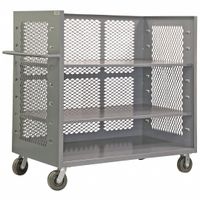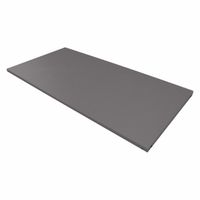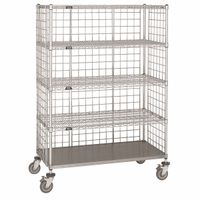Call +(254) 703 030 000 / 751 483 999 / 721 704 777
- Home
- Material Handling
- Transporting
- Carts Trucks
- Enclosed Shelf Stock Trucks Carts
.....Read More
Frequently Asked Questions
What are stock trucks used for?
Stock trucks are primarily used for the transportation of livestock, such as cattle, sheep, pigs, and other farm animals, from one location to another. These vehicles are specially designed to ensure the safe, efficient, and humane movement of animals over various distances. Key features of stock trucks include:
1. **Ventilation**: Adequate airflow is crucial to maintain the health and comfort of the animals during transit. Stock trucks are equipped with ventilation systems or open sides to ensure proper air circulation.
2. **Non-slip Flooring**: To prevent injuries, the floors of stock trucks are often made with non-slip materials or have textured surfaces to provide traction for the animals.
3. **Partitions and Dividers**: These are used to separate different types of animals or to prevent overcrowding, which can lead to stress or injury.
4. **Loading Ramps**: Stock trucks are equipped with ramps to facilitate the easy loading and unloading of animals. These ramps are designed to minimize stress and prevent injury.
5. **Watering Systems**: For long journeys, stock trucks may have built-in watering systems to keep animals hydrated.
6. **Temperature Control**: In some cases, especially for long-distance transport, stock trucks may have temperature control features to protect animals from extreme weather conditions.
7. **Compliance with Regulations**: Stock trucks must adhere to animal welfare regulations, which dictate standards for space, ventilation, and overall conditions during transport.
In addition to livestock, stock trucks can also be used to transport other goods, such as feed or equipment, when not in use for animals. They play a crucial role in the agricultural supply chain, ensuring that livestock reaches markets, processing facilities, or new grazing areas efficiently and safely.
What is the difference between metal and wire stock trucks?
Metal stock trucks and wire stock trucks are both used for transporting and storing materials, but they differ in construction and application.
Metal stock trucks are typically made from solid metal sheets or panels. They are robust and durable, making them suitable for heavy-duty applications. These trucks are often used in industrial settings to transport heavy or bulky items. The solid construction provides better protection for the contents, shielding them from external elements and potential damage. Metal stock trucks can also support heavier loads due to their sturdy build.
Wire stock trucks, on the other hand, are constructed using metal wire grids. This design makes them lighter and more maneuverable compared to metal stock trucks. The open wire construction allows for better visibility and ventilation, which is beneficial for items that need air circulation, such as perishables or damp materials. Wire stock trucks are often used in retail or food service environments where quick access and visibility of contents are important. They are generally easier to clean and maintain due to their open design.
In summary, the primary differences lie in their construction and use cases: metal stock trucks are solid and suitable for heavy-duty, protective transport, while wire stock trucks are lighter, offer better visibility and ventilation, and are ideal for environments where these features are advantageous.
How do stock trucks prevent items from falling off?
Stock trucks prevent items from falling off through a combination of design features and securing methods. Firstly, the truck bed or cargo area is often equipped with sidewalls or railings that provide a physical barrier to keep items contained. These walls can be fixed or adjustable, depending on the truck's design and the nature of the cargo.
Additionally, items are secured using various types of restraints. Straps, ropes, and nets are commonly used to tie down cargo, ensuring it remains stable during transit. These restraints are often attached to anchor points or tie-down hooks that are built into the truck bed. For heavier or bulkier items, ratchet straps or chains may be used for added security.
The use of tarps or covers is another method to prevent items from falling off. These covers are typically fastened over the cargo and secured to the truck, providing an additional layer of protection against movement and external elements like wind.
For trucks carrying pallets or stacked items, load bars or cargo bars can be used. These are adjustable bars that fit across the width of the truck bed, holding items in place by applying pressure against them.
In some cases, especially with larger trucks, the cargo area may be enclosed, either with a hard shell or a soft cover, effectively preventing any items from falling out.
Finally, proper loading techniques are crucial. Distributing weight evenly and placing heavier items at the bottom helps maintain balance and stability, reducing the risk of items shifting or falling during transport. Regular checks and adjustments during transit also ensure that all securing methods remain effective.
What are the benefits of using stock trucks in warehouses?
Using stock trucks in warehouses offers several benefits:
1. **Efficiency**: Stock trucks streamline the movement of goods, reducing the time needed for loading and unloading. This efficiency minimizes downtime and accelerates the overall workflow.
2. **Cost-Effectiveness**: By optimizing the transportation of goods within the warehouse, stock trucks reduce labor costs and the need for additional equipment, leading to significant cost savings.
3. **Space Utilization**: Stock trucks are designed to navigate tight spaces, allowing for better use of available storage areas. This maximizes the warehouse's capacity without requiring expansion.
4. **Flexibility**: These trucks can handle various types of goods, from pallets to individual items, providing flexibility in managing different inventory types and sizes.
5. **Safety**: Stock trucks are equipped with safety features that protect both the operator and the goods, reducing the risk of accidents and damage.
6. **Inventory Management**: They facilitate quick and accurate stock movement, improving inventory tracking and management. This leads to better stock control and reduced errors.
7. **Scalability**: As warehouse operations grow, stock trucks can easily be integrated into existing systems, supporting scalability without major overhauls.
8. **Reduced Manual Labor**: By automating the transportation of goods, stock trucks decrease the reliance on manual labor, reducing physical strain on workers and improving job satisfaction.
9. **Environmental Impact**: Modern stock trucks often come with energy-efficient technologies, reducing the warehouse's carbon footprint and contributing to sustainability goals.
10. **Improved Turnaround Time**: Faster movement of goods within the warehouse leads to quicker order fulfillment, enhancing customer satisfaction and competitive advantage.
How much weight can a metal stock truck typically hold?
A metal stock truck, commonly used in industrial and warehouse settings, typically has a weight capacity ranging from 1,000 to 3,000 pounds (approximately 450 to 1,360 kilograms). The exact weight capacity depends on several factors, including the design, materials used, and the manufacturer's specifications.
Heavy-duty models, often constructed from reinforced steel, can support the upper range of this capacity, making them suitable for transporting large quantities of metal stock, tools, or other heavy items. These trucks usually feature sturdy platforms, reinforced frames, and durable casters to ensure stability and ease of movement under heavy loads.
For lighter applications, smaller metal stock trucks with lower weight capacities are available, often made from lighter metals or alloys. These are ideal for less demanding tasks where maneuverability and ease of use are prioritized over maximum load capacity.
When selecting a metal stock truck, it's crucial to consider the specific requirements of the task, including the weight and type of materials to be transported, the environment in which the truck will be used, and any additional features such as brakes or ergonomic handles that may enhance safety and efficiency. Always refer to the manufacturer's guidelines to ensure the truck is used within its intended capacity to prevent accidents or damage.
Where are wire stock trucks commonly used?
Wire stock trucks are commonly used in various settings where efficient storage, organization, and transportation of goods are required. These include:
1. **Retail Environments**: In retail stores, wire stock trucks are used to transport merchandise from the stockroom to the sales floor. Their open design allows for easy visibility and access to products, facilitating quick restocking and inventory management.
2. **Warehouses and Distribution Centers**: These trucks are essential for moving goods within large storage facilities. They help in organizing products, making them easily accessible for order picking and packing processes.
3. **Manufacturing Facilities**: In manufacturing settings, wire stock trucks are used to transport raw materials, components, and finished products between different production areas. Their mobility aids in streamlining the production process.
4. **Healthcare Facilities**: Hospitals and clinics use wire stock trucks to transport medical supplies, equipment, and linens. Their open design ensures that items are easily accessible and can be quickly identified in urgent situations.
5. **Food Service and Hospitality**: In kitchens and catering services, wire stock trucks are used to move ingredients, prepared dishes, and kitchen equipment. Their design allows for proper ventilation, which is crucial for maintaining food safety standards.
6. **Libraries and Educational Institutions**: These trucks are used to transport books, supplies, and educational materials. Their mobility and capacity make them ideal for organizing and distributing resources across different areas.
7. **Cleaning and Maintenance**: Wire stock trucks are used by janitorial staff to carry cleaning supplies and equipment. Their sturdy construction and ease of movement make them suitable for navigating various environments.
Overall, wire stock trucks are versatile tools that enhance efficiency and organization across multiple industries by facilitating the easy movement and access to goods and materials.
What are the different types of stock carts available?
There are several types of stock carts designed to meet various needs in warehouses, retail environments, and industrial settings:
1. **Platform Carts**: These have a flat surface and are ideal for transporting large, heavy items. They often come with a handle for easy maneuverability.
2. **Utility Carts**: Typically multi-shelved, these carts are used for transporting smaller items and tools. They are common in maintenance and janitorial roles.
3. **Service Carts**: Similar to utility carts but often designed with specific features for food service or hospitality industries, such as enclosed sides or specific compartments.
4. **Hand Trucks**: Also known as dollies, these are L-shaped carts with two wheels, used for moving heavy boxes or appliances.
5. **Wire Carts**: Made with metal wire shelves, these are lightweight and allow for visibility and air circulation, suitable for transporting food or medical supplies.
6. **Bulk Handling Carts**: Designed for moving large quantities of items, these carts often have high sides to contain the load.
7. **Tilt Trucks**: These are large, wheeled containers that can be tilted to dump their contents, often used for waste or recycling.
8. **Security Carts**: Equipped with locking doors or lids, these carts are used to transport valuable or sensitive items securely.
9. **Lumber Carts**: Specifically designed for carrying long, heavy items like lumber or pipes, often featuring vertical supports.
10. **Order Picking Carts**: Used in warehouses for picking and transporting items for order fulfillment, often equipped with multiple shelves and compartments.
11. **Folding Carts**: These are collapsible for easy storage and are suitable for light-duty tasks.
Each type of cart is designed to optimize efficiency and safety for specific tasks, ensuring that materials are transported effectively within various environments.



